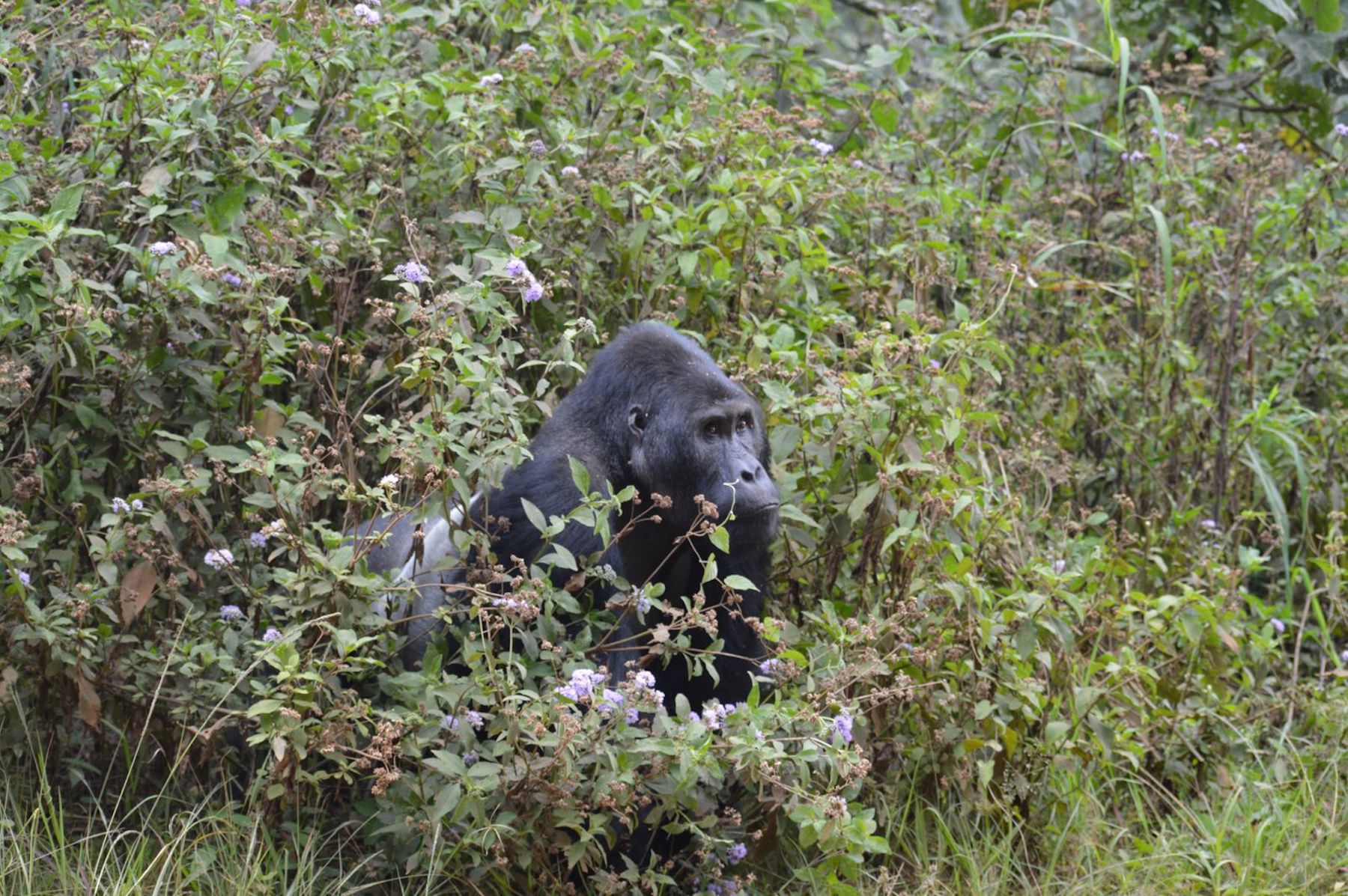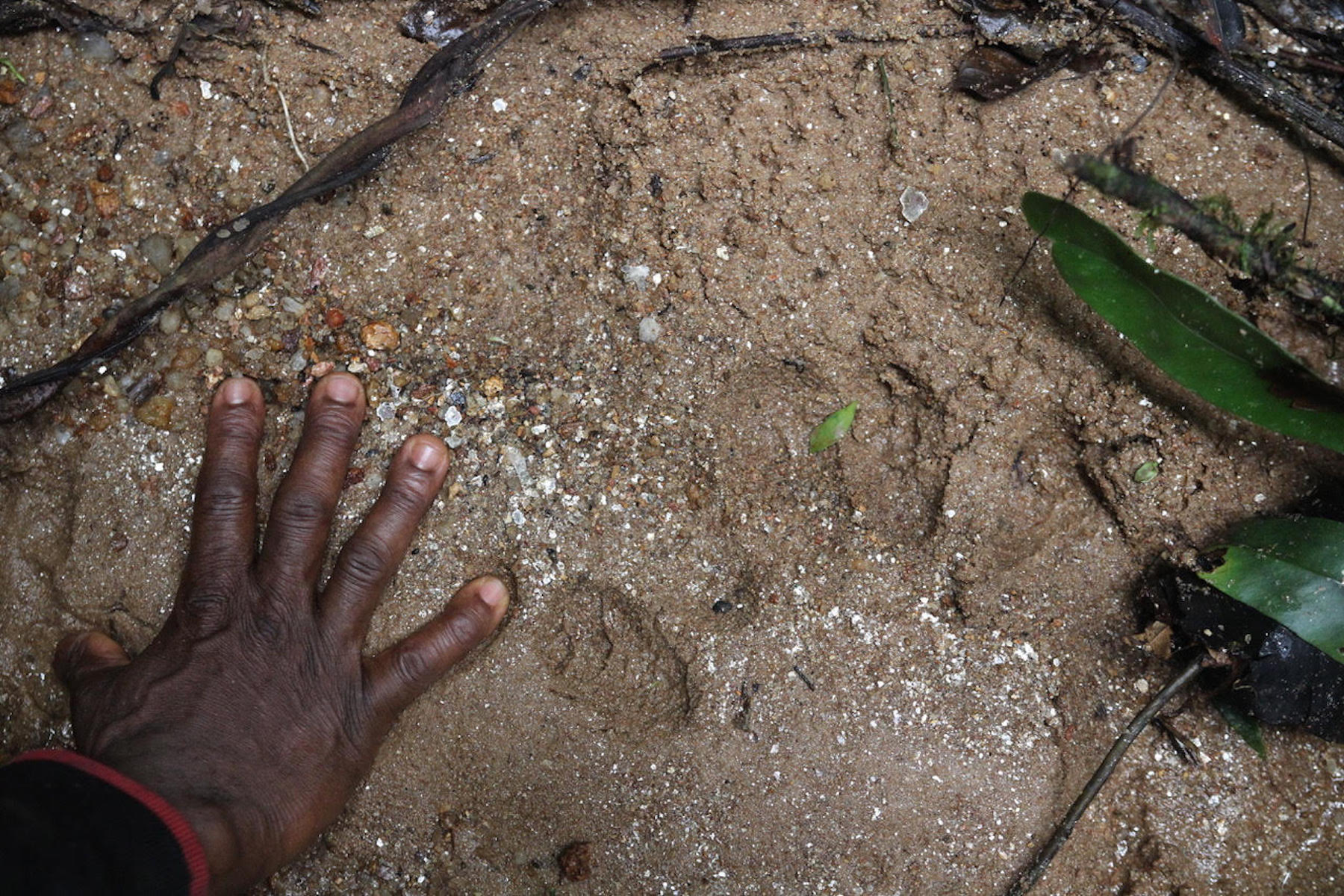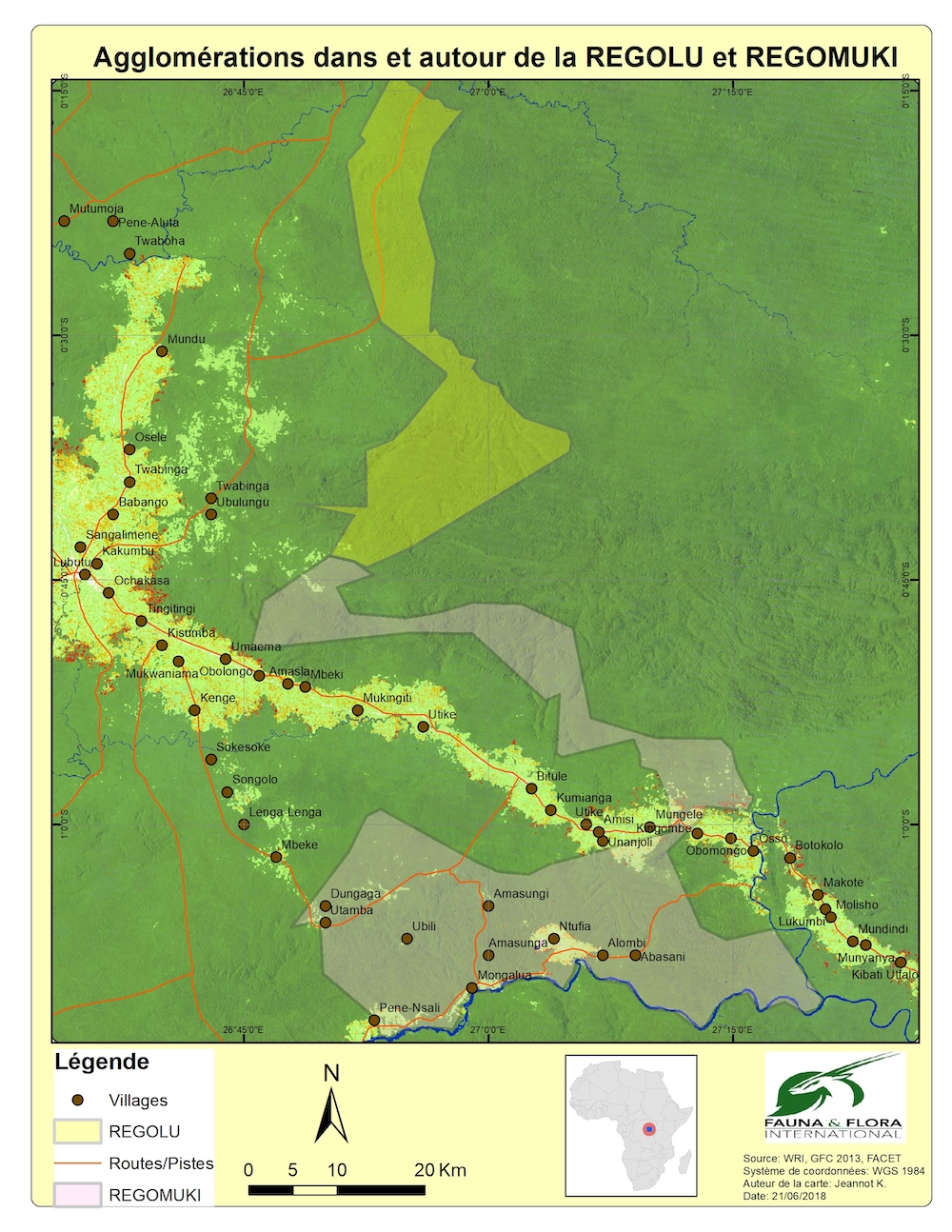- Maiko National Park is one of the most logistically challenging parks in the DRC and one of the most biodiverse. It is one of just two national parks in the world known to contain Grauer’s gorilla, a highly endangered and poorly understood eastern gorilla subspecies, and is also home to the endemic okapi and Congo peafowl, as well as forest elephants, leopards, chimpanzees, and giant pangolins.
- The most major threat to gorillas and other wildlife in Maiko is the bushmeat trade, but this is significantly exacerbated by another threat: artisanal mining. The Second Congo War coincided with a demand spike for a mineral called coltan that forms an essential component of all phones, computers, solar panels, and other electronics.
- Outside of the park, however, there is another threat to wildlife: increasing pressure from rising populations. As villages expand, they require more resources and begin to cut into primary forest to make way for subsistence crops. Satellite imagery show that trees are being cut down near Maiko. As the population expands, such habitat degradation will edge closer to the park itself—bringing even more pressure from the bushmeat trade.
- Villages can be a major threat to wildlife, but they also serve as essential allies to conservation work in the DRC. NGOs working to protect wildlife near Maiko are working closely with local communities to help achieve local buy-in and ensure the long-term sustainable development of the region.
The Democratic Republic of the Congo (DRC) holds 60 percent of the Congo rainforest, the second-largest rainforest in the world after the Amazon. Because of this, the country serves as an essential carbon sink, storing an estimated 22.9 gigatons of carbon. It is also one of the world’s most important biodiversity hotspots, hosting a dizzying array of plant and animal species. Animals such as the Vulnerable Congo peafowl (Afropavo congensis) and Endangered okapi (Okapia johnstoni), bonobo (Pan paniscus), and Grauer’s gorilla (Gorilla beringei grauer) are found nowhere else on Earth.
The DRC is also one of the ten most dangerous countries in the world, according to the Global Peace Index, and one of the most difficult places to carry out conservation work. In 2018, Virunga National Park, located in eastern DRC and home to the largest population of mountain gorillas in the world, was closed due to safety concerns after the death of a ranger and kidnapping of two tourists by a rebel militia. Rebel groups called “Mai-Mai” first retreated into the rainforest in the 1960s during the Congo Crisis, and became highly militarized during the country’s most recent civil war from 1997–2003.
The dense, impenetrable forest and rich resources found inside the country’s national parks have long made them a target of such groups, and perhaps no park in the country is more inaccessible than Virunga’s neighbor to the west: Maiko. Maiko National Park was initially a Belgian hunting reserve before it was declared a nature park in 1970 following the DRC’s independence. Since its creation, it has been inhabited and controlled by a rebel group known as the Simba Mai-Mai.

Covering over 10,000 square kilometers (3,860 square miles) of intact primary rainforest, “Maiko is an extraordinary national park,” says Robert Muir, co-founder of the Forgotten Parks Foundation. Maiko is both one of the most logistically challenging parks in the DRC and one of the most biodiverse. It is one of just two national parks in the world known to contain Grauer’s gorilla, a highly endangered and poorly understood eastern gorilla subspecies, and is also home to the endemic okapi and Congo peafowl, as well as forest elephants, leopards, chimpanzees, and giant pangolins.
Because of its importance to endangered and endemic species and to preserving the biodiversity of the Congo rainforest, international NGOs are working with local communities to overcome immense challenges and help protect the region’s wildlife.
Major threats to Maiko
While Maiko is understudied due to the presence of the Simba, there are three known threats to the region’s wildlife, all interconnected. The most major of these is the bushmeat trade, but this is significantly exacerbated by another threat: artisanal mining. The Second Congo War that militarized the Simba coincided with a demand spike for a mineral called coltan that forms an essential component of all phones, computers, solar panels, and other electronics.
“The main source of coltan in the early 2000s was the Congo,” says Damien Caillaud, a primate specialist who has worked with the Dian Fossey Gorilla Fund (DFGF) near Maiko. “It was critical for the electronic industry to have access to coltan, so the price of coltan was huge.”
Armed militia like the Simba quickly took control of illegal mining operations, essentially becoming “mining mafias.” While the mines themselves are typically small and don’t lead to much habitat degradation in their own right, they draw an influx of people and money, creating both a demand for bushmeat and a means to pay for it. This is devastating to local wildlife.
“What happens is that sometimes hundreds of people live near these mines, and they want to buy meat. Hunters end up joining these mines, and kill any wildlife within a five to ten kilometer radius to sell it to the miners,” explains Caillaud. “The direct impact of the mines is really not that big, but the indirect impact is huge.”

Muir with the Forgotten Parks Foundation has been working in the DRC for over 15 years, and was involved in surveys near Maiko in the early 2000s. He saw the mines’ effects first-hand. Before mining was introduced into the region, surveys near the park in 2005 turned up a rich array of wildlife. But just a few years later, the bushmeat trade had taken a toll.
“I was on one of the survey teams a few years later, and they had been completely denuded of their wildlife populations because of the pressure the mines were bringing to bear,” Muir says.
Section 1502 of the Dodd-Frank Act, passed in 2010 to better regulate “conflict minerals,” has helped reduce mining for coltan in the area, but coltan, cassiterite, and gold are all still mined in the region—including within Maiko itself. The bushmeat trade enabled by these mines is considered the single biggest threat to wildlife in the park.
But there may be a silver lining to Maiko’s occupation. While illegal timber logging and the charcoal trade have been major drivers of deforestation elsewhere in the DRC, this isn’t currently a problem within Maiko. “Although [they have] represented a management challenge, the Simba have essentially kept people out of that park,” says Muir. “As a result, where other areas and even other national parks have suffered significant losses of their wildlife populations, the Simba have inadvertently helped ensure the survival of these species in quite significant densities.”
Outside of the park, however, there is another threat to wildlife: increasing pressure from rising populations. As villages expand, they require more resources and begin to cut into primary forest to make way for subsistence crops. Satellite imagery from the University of Maryland visualized on the forest-monitoring platform Global Forest Watch shows that trees are being cut down near Maiko. As the population expands, such habitat degradation will edge closer to the park itself—bringing even more pressure from the bushmeat trade.

“If you’re close to a village, you won’t see any [wildlife],” Caillaud says. “Before the war, before there were so many weapons available, you could see monkeys in villages, in trees, jumping over the roads. Now it’s absolutely impossible. I have never seen a monkey less than five or ten kilometers away from a village.”
Villages can be a major threat to wildlife, but they also serve as essential allies to conservation work in the DRC. NGOs working to protect wildlife near Maiko – like DFGF and Fauna & Flora International (FFI) – work closely with local communities to help achieve local buy-in and ensure the long-term sustainable development of the region.
Protecting gorillas through community conservation
Grauer’s gorillas are particularly difficult to monitor and protect. These gorillas exist in isolated pockets distributed across thousands of square kilometers in eastern DRC that largely fall outside the protection of national parks. They are also a major target of the bushmeat trade because they are large and easy to track.
Because of its wide distribution in a part of the world that is difficult to access, the subspecies has gotten relatively little research attention. But what we do know is troubling. According to a 2016 study by FFI and the Wildlife Conservation Society, Grauer’s gorilla populations dropped by a staggering 77 percent over a 20-year period, falling from around 17,000 to 3,800 individuals. Another study, out in December 2018, found that this rapid population decline has caused the subspecies to lose 20 percent of its genetic diversity over just a few generations and increased the likelihood that dangerous mutations will spread through remaining populations.

To better understand and study the gorillas that remain requires the cooperation and support of local communities. A key tool for conservation groups hoping to achieve both goals is the development of community forests. The DRC introduced a “National Strategy for Community Forests” in 2016. This provides a legal basis for communities to manage their own forests— up to 50,000 hectares of land, the most of any country in the Congo Basin. With an estimated 75 million hectares of land in the DRC now available for community management, this strengthens NGOs’ ability to take a community development-based approach to protecting areas outside national parks.
DFGF and FFI have worked to establish three community conservation projects near Maiko to date. Nkubu Conservation Area, where DFGF works, covers about 1,000 square kilometers between Maiko and Kahuzi-Biega National Park, the only other national park known to house Grauer’s gorillas. FFI, meanwhile, works in two unofficially designated reserves buffering the western edge of Maiko to support local communities in their management. REGOLU, founded in 2004, and REGUMUKI, founded in 2007, are in the process of becoming officially recognized community forests. They cover about 500 square kilometers and 1,000 square kilometers respectively.
“You can’t do conservation in that area without having a relationship with the community,” says Angelique Todd, senior program manager for West and Central Africa with FFI. Community forests are “a way that we can get communities to be engaged and to be empowered about their land rights and be involved in conservation and decision-making about what’s happening on their land.”
Todd says FFI is deeply committed to ensuring that conservation work has a positive impact on the communities they work with. The organization focuses on win-win solutions to economic and food insecurity that help both villages and wildlife. Two major projects have included providing community members with more fuel-efficient stoves that require less firewood, and establishing a microloan program. While both of these projects are still small-scale, their biggest benefit has been building trust between FFI and the villages. This, in turn, increases community involvement in conservation work.
Last year, FFI was conducting a study on what crops local farmers were currently growing in order to inform future sustainable agriculture efforts when the team was taken hostage by the Simba overnight, and all their money to carry out the mission was stolen. But the communities insisted that the study continue, putting the team up at their houses and feeding them through the rest of the mission.
All of FFI’s staff on the ground are Congolese, Todd says. “They have to be. They really need to understand the communities and need to be able to go to the site and work alongside the communities.”
DFGF also staffs entirely from local villages. “From the beginning this community conservation program has been a partnership between the local community and the Dian Fossey Gorilla Fund, and I think this is why the community has always been very good to us,” Caillaud says. Community members will take action against poaching of their own accord, he says, and will even seize weapons and submit them to local authorities.


Today, FFI’s community forests are regularly patrolled by nine teams, while DFGF’s Nkubu Conservation Area is patrolled by five. These areas, though smaller than Maiko, are incredibly important while the park remains inaccessible—Nkubu alone has an estimated 150 gorillas. But a recent survey of Maiko arranged by DFGF and conducted by local Congolese staff has increased hope that healthy gorilla populations still exist within the park.
In 2017, Caillaud helped plan a survey of a small southern section of Maiko for the first time since the early 2000s. In less than one percent of the park, the team found evidence of 30 Grauer’s gorillas and believe there are likely many more.
The continuing importance of parks
While community forests and conservation areas are a good way to build trust and a sense of stewardship and responsibility in the local community, national parks are still an essential conservation tool. “I think you still need parks, because you still need to have areas where biodiversity is totally protected,” Todd says.
Muir has spent much of his career working to build the capacity of the DRC’s parks—first in Virunga after the civil war and then in Upemba, where he is based today. “My view is that national parks play an absolutely critical role in protecting biodiversity and wild areas,” Muir says. “Even paper parks have been shown to better protect flora and fauna within their borders—at the end of the day they are afforded the highest level of protection.”

He is a strong believer in the power of parks to protect the DRC’s wildlife while also engaging in community development for the surrounding area, and has had some success with this himself in Upemba, the first park he is managing as part of the Forgotten Parks Foundation. He is currently working to help finance teachers in the surrounding community so that parents can afford to send their children to school. He has also helped support alternatives to bushmeat through implementing more sustainable fisheries management and a livestock breeding scheme. While this is all in the early stages, he is hoping to someday scale up to other “forgotten parks” in the DRC and beyond.
Maiko is a high priority. “It one hundred percent fits the criteria of forgotten park. The world needs to wake up to what Maiko represents from a conservation point of view,” Muir says. “It’s a really important park, but it’s really challenging. If there isn’t significant international engagement in the next years that address some of these issues, we could find that we lose the important wildlife populations that Maiko is currently protecting.”
Banner image of a Grauer’s gorilla courtesy of Fauna & Flora International.
Editor’s note: This story was powered by Places to Watch, a Global Forest Watch (GFW) initiative designed to quickly identify concerning forest loss around the world and catalyze further investigation of these areas. Places to Watch draws on a combination of near-real-time satellite data, automated algorithms and field intelligence to identify new areas on a monthly basis. In partnership with Mongabay, GFW is supporting data-driven journalism by providing data and maps generated by Places to Watch. Mongabay maintains complete editorial independence over the stories reported using this data.
Feedback: Use this form to send a message to the editor of this post. If you want to post a public comment, you can do that at the bottom of the page.

